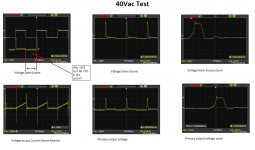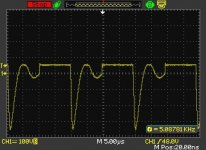giololucas
New member
Hi giololucas thanks for your reply but i don't get your point about one being low and the other low. BAsically as you send a signal through the Gate terminal of a mosfet it should cause a current flow and cause a voltage to appear at the DS terminals. When you remove the signal from the gate you stop the conduction at DS terminals thats how mosfet, BJT and IGBT ... work.
OR are you referring to voltage reversal that occurs in the transformer when the mosfet has finished charging the transformer inductance? Then this occurs at mosfet switch off and its how flyback work.
I am currently checking some waves from other projects they concide for current waveform but the waves am seeing were made with 110VAc. My feel is that this transformer is saturating badly in this application. I have already replaced the IRF840 by an SSS6N60 heat in mosfet is less after some minutes of operation But output voltage is 43Vdc for 50Vdc input. I could also have a short somewhere in my wires. I have an 1.8" 3315 AL/N2 toroid core taken from a car SMPS I will give this core a try to see how it goes as flyback require gapped core to avoid saturation
Hi zeus.
I understand that the mosfet works in your circuit this way:
When signal is applied to VGS, then VDS shorts the transformer to GND, like a switch.
Look at the picture I posted. Maybe it will be clearly to understand my doubt.
I´m almost sure that transformer is saturating, because it´s non gap.
Flyback Mosfet makes current flow in one direction only, this makes core magnetize, if you don´t switch current flow in reverse way core goes to saturation.
2 things you can try:
-Put reset zener diodes + resistors across primary, see TOP200Y datasheet (be carefull, fireworks may happen. I did it one time.)
-Use a gap in center lag (your PSU core was used for Half bridge, current must flow in 2 directions). If you use gap, then you will have to add more turns because AL is reduced (I don´t know how much).


